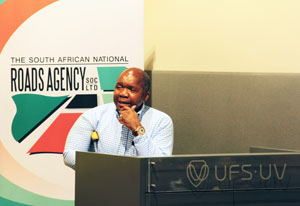 MEC: Butana Khomphela
Photo: Jerry Mokoroane
|
The University of the Free State (UFS) in partnership with the South African National Roads Agency launched the SANRAL Chair in Science, Mathematics and Technology Education on the Bloemfontein Campus on 11 September 2014. Prof Loyiso Jita has been appointed as the first SANRAL Chair. He is a professor in the School of Mathematics, Natural Sciences and Technology at the UFS, where he shares his expertise in science teaching, which has been influenced by his broad and deep intellectual and experiential engagements both internationally and domestically.
Speaking at the event were Prof Jonathan Jansen, Vice-Chancellor and Rector of the UFS; Dr Choice Makhetha, Vice-Rector: External Relations; Prof Jita, the inaugural SANRAL Chair; the Free State MEC for Police, Roads and Transport, Mr Butana Komphela and Mr Nazir Alli, CEO of SANRAL.
At the event, Prof Jansen celebrated that “SANRAL has rewarded the faith in our children to do well in science and mathematics with this Chair.”
This SANRAL Chair in Science, Mathematics and Technology Education will help to improve the quality of teaching in these vital subjects at schools in the province. It complements the university’s School Partnership Project (SPP) – a flagship initiative launched by Prof Jansen.
The SANRAL endowment will enable the university to hone in on the ‘gateway subjects’ of mathematics and natural science. At school level, it will help to train teachers, support student-teacher interns, and incentivise education results so that participating schools become centres of excellence. At an academic level, the SANRAL Chair will supervise a cohort of doctoral and masters students, while also guiding research and publications in mathematics, science and technology education.
Through the endowment, SANRAL will assist the UFS in producing education leaders who can turn around maths and science education in disadvantaged schools throughout Southern Africa.
For the full text, read:
New SANRAL Chair in Science, Mathematics and Technology Education